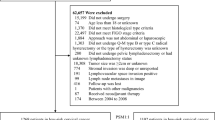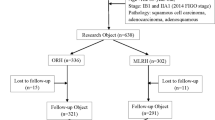Abstract
Background
To investigate the survival outcomes of stage IB1 cervical cancer patients with tumor size ≤ 2 cm who underwent laparoscopic or abdominal radical hysterectomy.
Methods
We retrospectively analyzed stage IB1 cervical cancer patients with a tumor size ≤ 2 cm who underwent laparoscopic or abdominal radical hysterectomy in China between 2004 and 2016. A real-world study (RWS) and 1:1 matching was used in the study.
Results
After 1:1 matching, laparoscopic (n = 926) and abdominal radical hysterectomy (n = 926) had similar 5-year overall survival and disease-free survival rates in stage IB1 cervical cancer with a tumor size ≤ 2 cm. Subsequently, in cervical squamous carcinoma with tumor size ≤ 2 cm, the laparoscopic and abdominal groups (724 cases, respectively) showed comparable 5-year overall survival and disease-free survival rates. Finally, in cervical adenocarcinoma or adenosquamous carcinoma with tumor size ≤ 2 cm, the laparoscopic group (n = 174) had a similar 5-year overall survival rate but a lower disease-free survival rate compared to those of the abdominal group (disease-free survival: 89.9% vs. 98.0%, respectively, P = 0.006; hazard ratio (HR), 5.094; 95% confidence interval (CI), 1.400–18.535; P = 0.013; n = 174). The RWS results were similar to the 1:1 matching results.
Conclusions
Patients with squamous cell carcinoma in stage IB1 cervical cancer with tumor size ≤ 2 cm might be suitable for laparoscopic surgery, while patients with adenocarcinoma or adenosquamous carcinoma with tumor size ≤ 2 cm are not candidates for laparoscopic surgery.



Similar content being viewed by others
References
Torre LA, Islami F, Siegel RL et al (2017) Global cancer in women: burden and trends. Cancer Epidemiol Biomark Prev 26:444–457
Chen W, Zheng R, Baade PD et al (2016) Cancer statistics in China, 2015. CA Cancer J Clin 66:115–132
Bhatla N, Denny L (2018) FIGO cancer report 2018. Int J Gynecol Obstet 143:2–3
National Comprehensive Cancer Network (2019) NCCN clinical practice guidelines in oncology, cervical cancer, version 4. https://www.nccn.org/Professionals/physician_gls/pdf/cervical.pdf. Accessed 29 Mar 2019
Chen CH, Chiu LH, Chang CW et al (2014) Comparing robotic surgery with conventional laparoscopy and laparotomy for cervical cancer management. Int J Gynecol Cancer 24(6):S203–S204
Wang YZ, Deng L, Xu HC et al (2015) Laparoscopy versus laparotomy for the management of early stage cervical cancer. BMC Cancer 15(1):928
Kucukmetin A, Biliatis I, Ratnavelu N et al (2014) Laparoscopic radical trachelectomy is an alternative to laparotomy with improved perioperative outcomes in patients with early-stage cervical cancer. Int J Gynecol Cancer 24(1):135–140
Mendivil AA, Rettenmaier MA, Abaid LN et al (2016) Survival rate comparisons amongst cervical cancer patients treated with an open, robotic-assisted or laparoscopic radical hysterectomy: a five year experience. Surg Oncol 25(1):66–71
Angelopoulos G, Etman A, Cruickshank DJ et al (2015) Total laparoscopic radical hysterectomy: a change in practice for the management of early stage cervical cancer in a UK cancer center. Eur J Gynaecol Oncol. 36(6):711–715
Ditto A, Martinelli F, Bogani G et al (2015) Implementation of laparoscopic approach for type B radical hysterectomy: a comparison with open surgical operations. Eur J Surg Oncol 41(1):34–39. https://doi.org/10.1016/j.ejso.2014.10.058
Ramirez PT, Frumovitz M, Pareja R et al (2018) Minimally invasive versus abdominal radical hysterectomy for cervical cancer. N Engl J Med 379(20):1895–1904
Melamed A, Margul DJ, Chen L et al (2018) Survival after minimally invasive radical hysterectomy for early-stage cervical cancer. N Engl J Med 379(20):1905–1914
Nezhat CR, Burrell MO, Nezhat FR et al (1992) Laparoscopic radical hysterectomy with paraaortic and pelvic node dissection. Am J Obstet Gynecol. 166(3):864–865
Zhang W, Chen C, Liu P et al (2019) Impact of pelvic MRI in routine clinical practice on staging of IB1-IIA2 cervical cancer. Cancer Manag Res. 11:3603–3609
Querleu D, Morrow CP (2008) Classification of radical hysterectomy. Lancet Oncol 9:297–303
Li G, Yan X, Shang H et al (2007) A comparison of laparoscopic radical hysterectomy and pelvic lymphadenectomy and laparotomy in the treatment of Ib–IIa cervical cancer. Gynecol Oncol 105(1):176–180
Kong TW, Chang SJ, Lee J et al (2014) Comparison of laparoscopic versus abdominal radical hysterectomy for FIGO stage IB and IIA cervical cancer with tumor diameter of 3 cm or greater. Int J Gynecol Cancer 24(2):280–288
Wang W, Chu HJ, Shang CL et al (2016) Long-term oncological outcomes after laparoscopic versus abdominal radical hysterectomy in stage IA2 to IIA2 cervical cancer. Int J Gynecol Cancer 26(7):1264–1273
Sert BM, Boggess JF, Ahmad S et al (2016) Robot-assisted versus open radical hysterectomy: a multi-institutional experience for early-stage cervical cancer. Eur J Surg Oncol 42:513–522
Kanao H, Matsuo K, Aoki Y et al (2019) Feasibility and outcome of total laparoscopic radical hysterectomy with no-look no-touch technique for FIGO IB1 cervical cancer. J Gynecol Oncol 30(3):e71. https://doi.org/10.3802/jgo.2019.30.e71
Li G, Huang H, Zheng L et al (2001) Laparoscopic surgery in the treatment of early uterine malignancies: a report of 8 cases. Chin J Obstet Gynecol 36(8):486–488
Kim SI, Cho JH, Seol A et al (2019) Comparison of survival outcomes between minimally invasive surgery and conventional open surgery for radical hysterectomy as primary treatment in patients with stage IB1–IIA2 cervical cancer. Gynecol Oncol. 153(1):3–12
Kim SI, Lee M, Lee S et al (2019) Impact of laparoscopic radical hysterectomy on survival outcome in patients with FIGO stage IB cervical cancer: A matching study of two institutional hospitals in Korea. Gynecol Oncol. 19:314088. https://doi.org/10.1016/j.ygyno.2019.07.019
Hu K, Wang W, Liu X et al (2018) Comparison of treatment outcomes between squamous cell carcinoma and adenocarcinoma of cervix after definitive radiotherapy or concurrent chemoradiotherapy. Radiat Oncol. 13(1):249
Yokoi E, Mabuchi S, Takahashi R et al (2017) Impact of histological subtype on survival in patients with locally advanced cervical cancer that were treated with definitive radiotherapy:adenocarcinoma/adenosquamous carcinoma versus squamous cell carcinoma. J Gynecol Oncol 28(2):e19
Cai HB, Chen HZ, Zhou YF et al (2009) Class II radical hysterectomy in low-risk IB squamous cell carcinoma of cervix. Int J Gynecol Cancer 19(1):46–49
Bezerra AL, Martins MR, Bezerra SM et al (2011) Class II radical hysterectomy for stage I–IIA cervix cancer: prognostic factors associated to recurrence and survival in a northeast Brazil experience. J Surg Oncol 104(3):255–259
Ditto A, Martinelli F, Ramondino S et al (2014) Class II versus Class III radical hysterectomy in early cervical cancer: an observational study in a tertiary center. Eur J Surg Oncol 40(7):883–890
Chen C, Wang W, Liu P et al (2020) Survival after abdominal Q-M type B versus C2 radical hysterectomy for early-stage cervical cancer. Cancer Manag Res (accepted)
Chong GO, Park NY, Hong DG et al (2009) Learning curve of laparoscopic radical hysterectomy with pelvic and/or para-aortic lymphadenectomy in the early and locally advanced cervical cancer comparison of the first 50 and second 50 cases. Int J Gynecol Cancer 19(8):1459–1464
Suh DH, Cho H, Kim K, No JH, Kim Y (2015) Matched-case comparisons in a single institution to determine critical points for inexperienced surgeons’ successful performances of laparoscopic radical hysterectomy versus abdominal radical hysterectomy in stage IA2–IIA cervical cancer. PLoS ONE 10(6):e131170
Acknowledgements
This study was supported by the National Science and Technology Support Program of China (2014BAI05B03), the National Natural Science Fund of Guangdong (2015A030311024), and the Science and Technology Plan of Guangzhou (158100075). We are grateful to Min Hao (Department of Obstetrics and Gynecology, The Second Hospital of Shanxi Medical University), Wuliang Wang (Department of Obstetrics and Gynecology, The Second Affiliated Hospital of Zhengzhou University), Ying Yang (Department of Obstetrics and Gynecology, Xinqiao Hospital, Army Medical University), Shan Kang (Department of Obstetrics and Gynecology, The Fourth Hospital of Hebei Medical University), Bin Ling (Department of Obstetrics and Gynecology, China-Japan Friendship Hospital), Xinli Sun and Hongwei Zhao (Department of Gynecology, Shanxi Cancer Hospital), Lizhi Liang and Jihong Liu (Department of Gynecologic Oncology, Sun Yat-sen University Cancer Center), Yu Guo and Lihong Lin (Department of Gynecology, Anyang Tumor Hospital), Li Wang (Department of Gynecology, The Affiliated Tumor Hospital of Zhengzhou University), Weidong Zhao (Department of Gynecology and Oncology, Anhui Provincial Cancer Hospital), Donglin Li and Wentong Zhao (Department of Obstetrics and Gynecology, Guizhou Provincial People’s Hospital), Jianxin Guo (Department of Obstetrics and Gynecology, Research Institute of Surgery, Daping Hospital, The Third Military Medical University), Xuemei Zhan and Mingwei Li (Department of Gynecology, Jiangmen Central Hospital), Weifeng Zhang (Department of Obstetrics and Gynecology, Ningbo Women & Children's Hospital), Peiyan Du (Department of Gynecological Oncology, the Affiliated Cancer Hospital and Institute of Guangzhou Medical University), Ziyu Fang (Department of Obstetrics and Gynecology, Liuzhou Workers' Hospital), Rui Yang (Department of Obstetrics and Gynecology, Shenzhen Hospital of Peking University), Long Chen (Department of Obstetrics and Gynecology, Qingdao Municipal Hospital), Encheng Dai and Ruilei Liu (Department of Obstetrics and Gynecology, Linyi People's Hospital), Mubiao Liu and Yuanli He (Department of Obstetrics and Gynecology, Zhujiang Hospital, Southern Medical University), Jilong Yao and Zhihua Liu (Department of Obstetrics and Gynecology, Shenzhen Maternity & Child Health Hospital), Xueqin Wang (Department of Obstetrics and Gynecology, The Fifth Affiliated Hospital of Southern Medical University), Anwei Lu (Department of Obstetrics and Gynecology, Maternal and Child Health Hospital of Guiyang Province), Shuangling Jin (Department of Obstetrics and Gynecology, Peace Hospital affiliated to Changzhi Medical College), Ben Ma (Department of Obstetrics and Gynecology, Guangzhou First People's Hospital), Zhonghai Wang (Department of Obstetrics and Gynecology, Shenzhen Nanshan People's Hospital), Lin Zhu (Department of Gynecology, The Second Hospital of Shandong University), Hongxin Pan (Department of Obstetrics and Gynecology, the 3rd Affiliated Hospital of Shenzhen University, Luohu People's Hospital), Qianyong Zhu [Department of Obstetrics and Gynecology, No. 153, Center Hospital of Liberation Army (Hospital No. 988 of the Chinese People's Liberation Army Joint Support Force)], Xiaohong Wang [Department of Obstetrics and Gynecology, Laiwu People's Hospital (Jinan City People's Hospital)], and Dingyuan Zeng and Zhong Lin (Department of Obstetrics and Gynecology, Maternal and Child Health Care Hospital of Liuzhou) for providing cases.
Author information
Authors and Affiliations
Corresponding author
Ethics declarations
Conflict of interest
There are no conflicts of interest.
Additional information
Publisher's Note
Springer Nature remains neutral with regard to jurisdictional claims in published maps and institutional affiliations.
About this article
Cite this article
Chen, C., Liu, P., Ni, Y. et al. Laparoscopic versus abdominal radical hysterectomy for stage IB1 cervical cancer patients with tumor size ≤ 2 cm: a case-matched control study . Int J Clin Oncol 25, 937–947 (2020). https://doi.org/10.1007/s10147-020-01630-z
Received:
Accepted:
Published:
Issue Date:
DOI: https://doi.org/10.1007/s10147-020-01630-z




